Prologue - Added January 2005:
Some time ago, I decided to do a comparison of two of the more frequently mentioned earphones on Head-Fi, along with a headphone that not so many have talked about. The Shure E2c has since it's introduction made a mark on the portable audio earphone market, and has emerged as a very serious competitor to the likes of Sony. The Sony MDR-EX71 is an update of the older EX70, the first consumer low-cost isolating in-earphone from a major manufacturer which didn't totally suck. The PXC250 is (or rather was at the time of the review) a newly-released noise-cancellation phone which was based on the company's PX200 closed mini headphone. So without further ado, here's the comparison...
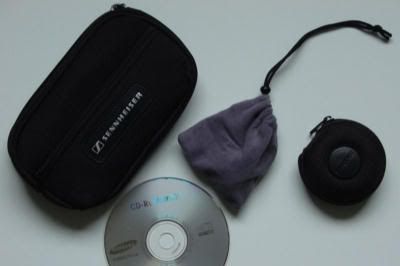
PXC250, MDR-EX71SL and E2c in their respective pouches.
Shure E2c
A warmish sound with reasonable extension (for a headphone… very good for an earphone!) in both directions. Bass was well represented but not overwhelming, mids were slightly upfront which contributed to the warmness, and the trebles were slightly recessed. On the whole a non fatiguing sound when heard at reasonable volumes. Not a big feeling of space with these phones, with a compacted soundstage. Accuracy is excellent.
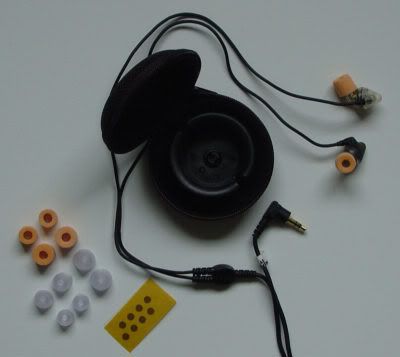
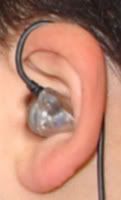
The phones ship with a well designed semi-hard case, small, medium and large silicone tips, small, medium and large expanding foam tips,, and a sheet of “earwax blockers” which are applied to the tips of the earphone tubes. The 3.5mm plug is a somewhat thicker than standard 90-degree type which may not fit all remotes. Shure provides a two-year warranty.
Volume reference: 30 out of 40 (iRiver MP3 CD player with 8mw/channel output volume setting for quite loud music)
Any of the portables powered this to a maximum deafening level. Overall a solid sound, generally suitable for all purpose use. Good for Pop and Rock, not so good for Classical
Sony MDR-EX71
In theory, this should have done well. It has a better extension at the tops than the E2, bass practically as deep/non blobby as the E2, and a wider soundstage. Accuracy is not that bad either. However the EX71 had a poor showing due to its overall cheap-feeling harsh sound. In some cases the snares sounded like oversized coke cans. The treble is harsh but clear, the mids are recessed and feel distant, and the bass is quite powerful and reasonably unbloated. The soundstage is somewhat wide feeling but completely 2-D.
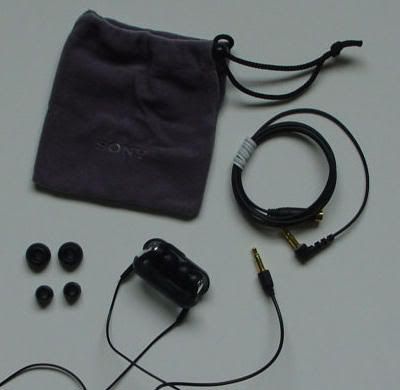
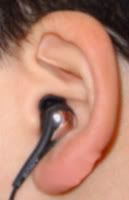
The phones ship with an simple yet clever plastic phone storage unit which encases only the earphones themselves, small, medium and large silicone tips, and a cloth pouch. SL models ship with a short cable and an additional extension cable. The 3.5mm plug is a ‘ultra slim/compact’ type which will fit all remotes. Sony provides a one-year warranty.
Volume reference: 35 out of 40
It’s noticeably less efficient than the E2c. I have to give credit to Sony for making definite changes to the sound and striving to improve their products, but they have gone to the opposite extreme with the EX71 and it is far too harsh. If they can dampen that a little, then you might have a great alternative to the E2c, especially for classical.
Sennheiser PXC250
This has a cooler and less upfront sound than the E2. Although the hiss of the amp/noise cancelling circuitry could be heard in silence, in normal use it should it should not be audible. The bass is very strong on this phone (more than any other phone) yet with minimal bloat, and sometimes in passages with long droning bass lines that could slightly overpower the rest of the sound. Drums are another matter and the PXC250 does this better than any other phone in this test. Bass drums came across almost tangibly. Accuracy is good, rendering complex passages with good composure. This is of course as long as the batteries last (2 AAA batteries in the noise cancelling stick, and they do last for a very long time). Without power it sounds like a very quiet PX200... Not that great.
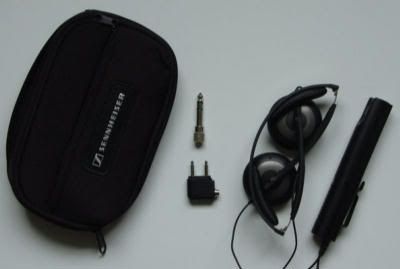
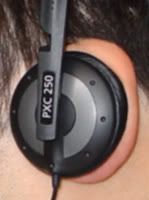
The phones ship with aircraft adapter, 6.4mm adaptor and a large cloth zip-up bag. The 3.5mm plug is a ‘slim’ type which will fit practically all remotes. The cancellation ‘stick’ has a belt clip which swivels 360 degrees with 90 degree detents for versatility. Sennheiser provides a two-year warranty.
Volume reference: 40 out of 40
Clearly not as efficient as the other phones, but not unusably quiet either with any of the portables. Europe-limited portables with 3mw and less will probably have problems driving these. The sound is quite easily the best of the three, very compatible with all music styles.
COMFORT / USABILITY
Phones rated on comfort, ability to pack/unpack easily, ability to disengage temporarily, and other general usability factors. The margins of the ratings are fairly small but there has to be a winner, and as the best thought out product for the above parameters the win goes to Sony.
3rd Place: The E2c was the worst for Comfort/Usability. This is because to get a good seal you must drive the phone a fair way into your ear, yet the phones’ ear tubes are quite wide, leading to some degree of discomfort. The discomfort is perfectly bearable though, and it doesn’t particularly get worse over time. You are expected to hook the earphone cables around your ears but they frequently fall off. If the E2c needs to be taken off momentarily, there is no easy way to let them hang around your neck. The only quick way without third party fixes or accessories is to unplug one ear. The cable tangles quite easily.
2nd Place: The PXC250’s profusion of cables and the extra cancellation ‘stick’ makes this the least portable of the three, and combined with cables that tangle quite easily, it is the least manageable in everyday operation. The headphone can be worn (somewhat uncomfortably) around the neck when not in use. The cancellation stick can be clipped around the belt or other such place. Phone comfort is very good for short and long term wearing and goes some way towards offsetting the problems in other areas.
1st place: The MDR-EX71SL has a short cord which works well for portables with remotes. The EX71LP has a regular longish cable. Because the EX71’s cable to the right ear goes behind the neck, the phones can be unplugged and left around the neck when temporarily not in use. The cable is resistant to tangling. The comfort of the EX71 is good, however since they do not go as far into the ear canal as the E2 they are very prone to being pulled out. Also due to the asymmetric nature of the cable, you cannot leave your remote dangling… It has to be secured somewhere or the left earbud will be regularly unplugged by accident. The plastic case is ingeniously simple, quick to use and useful.
ISOLATION
Assuming train, overland, reasonably crowded.
3rd Place: The MDR-EX71 doesn’t really isolate much in comparison to the other two phones. Conversations are still audible, and travelling noise is still very evident.
2nd Place: With the PXC250, all low frequency components (train rumblings, etc) are dramatically reduced. Conversations can still be heard and those happening close to the listener can intrude very clearly into the listening experience.
1st Place: The E2c (foam tips) uniformly cuts external sound by an impressive level. For general purpose portable isolation this is the most useful. However low frequency components are not attenuated as strongly as the PXC250.
OVERALL RANKINGS
3rd Place: Sony MDR-EX71. A distant third in terms of sound. Design and usability features score much higher, but not enough to stop it from coming last. It is the cheapest however, so that's not a disaster.
2nd Place: Sennheiser PXC250. The best sound of the trio but usability, portability and isolation issues persist to stop it winning. The most difficult to drive too, so users with weak or Euro-limited portable should avoid this unit. Noise cancellation is a very different experience, very nice for aircraft travel.
1st Place: Shure E2c (foam tips). It's got good sound albeit with a little bit off the treble, isolation is excellent and it's very portable. The puck shaped case is very handy. The E2c is easy to drive from even very weak portables. In overall terms I've no hesitation in declaring it the winner.
Although it doesn't win in all areas and is not the absolute best sounding, the Shure E2c in my opinion takes the top prize as the best solution for isolating portable ear gear in this price range. The tests did however impress upon me that the PXC250 is the best sounding (in the test noise cancellation was always on) with a wide variety of music. Although it was not a winner, a surprise was the EX71 which is very different to the 70. Whereas the previous MDR-EX70 was a cotton wool and syrup bloatfest, the EX71 beings a steely, somewhat harsh, distant but relatively (to the EX70 that is) controlled sound to the table.
Shure: E2c
Sennheiser: PXC250
Sony: MDR-EX71SL
Isolation versus cancellation
Many have said that the PXC250 doesn’t block out enough noise for their needs. Whether you choose cancellation or isolation really depends on what your needs are. And your needs will change according to how you travel. As I’ve established the PXC250 sounds better and may be more comfortable to some. So it still has an edge… You should consider using it if it fits your profile.
What the cancellation of the PXC250 does not do well is to block out frequencies above the mid-bass. If you fly, the E2 should be your choice if you travel Coach or Business regularly because you never know when the dreaded Screaming Baby will turn up right next to you. If you fly using corporate transport or First, then the PXC250 is your best bet. The closed design gets rid of the fatiguing air-con hiss and the cancellation eliminates engine drone, but doesn’t preclude you from hearing important announcements or your colleagues. Another area where the PXC250 performed poorly was in the London Underground. Frequently on the Underground there is an incredible howling noise caused by the rails, bogies and the enclosed space which the PXC250 cannot cancel out at all. On overland rail travel however the PXC250 is very effective, soaking up the travelling noises.
The cancellation of the PXC250 is interesting. Where the E2 and to a lesser extent the EX71 blocks out outside sound so it feels like sounds are in your ear, the PXC250’s cancellation seems to preserve the sense of space around you while dramatically reducing the outside noise. This is the reason that many feel that they are not getting reduction of unwanted sounds… yet a quick release of one of the earcups will tell you that a considerable amount of noise is being attenuated.
A warmish sound with reasonable extension (for a headphone… very good for an earphone!) in both directions. Bass was well represented but not overwhelming, mids were slightly upfront which contributed to the warmness, and the trebles were slightly recessed. On the whole a non fatiguing sound when heard at reasonable volumes. Not a big feeling of space with these phones, with a compacted soundstage. Accuracy is excellent.


The phones ship with a well designed semi-hard case, small, medium and large silicone tips, small, medium and large expanding foam tips,, and a sheet of “earwax blockers” which are applied to the tips of the earphone tubes. The 3.5mm plug is a somewhat thicker than standard 90-degree type which may not fit all remotes. Shure provides a two-year warranty.
Volume reference: 30 out of 40 (iRiver MP3 CD player with 8mw/channel output volume setting for quite loud music)
Any of the portables powered this to a maximum deafening level. Overall a solid sound, generally suitable for all purpose use. Good for Pop and Rock, not so good for Classical
Sony MDR-EX71
In theory, this should have done well. It has a better extension at the tops than the E2, bass practically as deep/non blobby as the E2, and a wider soundstage. Accuracy is not that bad either. However the EX71 had a poor showing due to its overall cheap-feeling harsh sound. In some cases the snares sounded like oversized coke cans. The treble is harsh but clear, the mids are recessed and feel distant, and the bass is quite powerful and reasonably unbloated. The soundstage is somewhat wide feeling but completely 2-D.


The phones ship with an simple yet clever plastic phone storage unit which encases only the earphones themselves, small, medium and large silicone tips, and a cloth pouch. SL models ship with a short cable and an additional extension cable. The 3.5mm plug is a ‘ultra slim/compact’ type which will fit all remotes. Sony provides a one-year warranty.
Volume reference: 35 out of 40
It’s noticeably less efficient than the E2c. I have to give credit to Sony for making definite changes to the sound and striving to improve their products, but they have gone to the opposite extreme with the EX71 and it is far too harsh. If they can dampen that a little, then you might have a great alternative to the E2c, especially for classical.
Sennheiser PXC250
This has a cooler and less upfront sound than the E2. Although the hiss of the amp/noise cancelling circuitry could be heard in silence, in normal use it should it should not be audible. The bass is very strong on this phone (more than any other phone) yet with minimal bloat, and sometimes in passages with long droning bass lines that could slightly overpower the rest of the sound. Drums are another matter and the PXC250 does this better than any other phone in this test. Bass drums came across almost tangibly. Accuracy is good, rendering complex passages with good composure. This is of course as long as the batteries last (2 AAA batteries in the noise cancelling stick, and they do last for a very long time). Without power it sounds like a very quiet PX200... Not that great.


The phones ship with aircraft adapter, 6.4mm adaptor and a large cloth zip-up bag. The 3.5mm plug is a ‘slim’ type which will fit practically all remotes. The cancellation ‘stick’ has a belt clip which swivels 360 degrees with 90 degree detents for versatility. Sennheiser provides a two-year warranty.
Volume reference: 40 out of 40
Clearly not as efficient as the other phones, but not unusably quiet either with any of the portables. Europe-limited portables with 3mw and less will probably have problems driving these. The sound is quite easily the best of the three, very compatible with all music styles.
COMFORT / USABILITY
Phones rated on comfort, ability to pack/unpack easily, ability to disengage temporarily, and other general usability factors. The margins of the ratings are fairly small but there has to be a winner, and as the best thought out product for the above parameters the win goes to Sony.
3rd Place: The E2c was the worst for Comfort/Usability. This is because to get a good seal you must drive the phone a fair way into your ear, yet the phones’ ear tubes are quite wide, leading to some degree of discomfort. The discomfort is perfectly bearable though, and it doesn’t particularly get worse over time. You are expected to hook the earphone cables around your ears but they frequently fall off. If the E2c needs to be taken off momentarily, there is no easy way to let them hang around your neck. The only quick way without third party fixes or accessories is to unplug one ear. The cable tangles quite easily.
2nd Place: The PXC250’s profusion of cables and the extra cancellation ‘stick’ makes this the least portable of the three, and combined with cables that tangle quite easily, it is the least manageable in everyday operation. The headphone can be worn (somewhat uncomfortably) around the neck when not in use. The cancellation stick can be clipped around the belt or other such place. Phone comfort is very good for short and long term wearing and goes some way towards offsetting the problems in other areas.
1st place: The MDR-EX71SL has a short cord which works well for portables with remotes. The EX71LP has a regular longish cable. Because the EX71’s cable to the right ear goes behind the neck, the phones can be unplugged and left around the neck when temporarily not in use. The cable is resistant to tangling. The comfort of the EX71 is good, however since they do not go as far into the ear canal as the E2 they are very prone to being pulled out. Also due to the asymmetric nature of the cable, you cannot leave your remote dangling… It has to be secured somewhere or the left earbud will be regularly unplugged by accident. The plastic case is ingeniously simple, quick to use and useful.
ISOLATION
Assuming train, overland, reasonably crowded.
3rd Place: The MDR-EX71 doesn’t really isolate much in comparison to the other two phones. Conversations are still audible, and travelling noise is still very evident.
2nd Place: With the PXC250, all low frequency components (train rumblings, etc) are dramatically reduced. Conversations can still be heard and those happening close to the listener can intrude very clearly into the listening experience.
1st Place: The E2c (foam tips) uniformly cuts external sound by an impressive level. For general purpose portable isolation this is the most useful. However low frequency components are not attenuated as strongly as the PXC250.
OVERALL RANKINGS
3rd Place: Sony MDR-EX71. A distant third in terms of sound. Design and usability features score much higher, but not enough to stop it from coming last. It is the cheapest however, so that's not a disaster.
2nd Place: Sennheiser PXC250. The best sound of the trio but usability, portability and isolation issues persist to stop it winning. The most difficult to drive too, so users with weak or Euro-limited portable should avoid this unit. Noise cancellation is a very different experience, very nice for aircraft travel.
1st Place: Shure E2c (foam tips). It's got good sound albeit with a little bit off the treble, isolation is excellent and it's very portable. The puck shaped case is very handy. The E2c is easy to drive from even very weak portables. In overall terms I've no hesitation in declaring it the winner.
Although it doesn't win in all areas and is not the absolute best sounding, the Shure E2c in my opinion takes the top prize as the best solution for isolating portable ear gear in this price range. The tests did however impress upon me that the PXC250 is the best sounding (in the test noise cancellation was always on) with a wide variety of music. Although it was not a winner, a surprise was the EX71 which is very different to the 70. Whereas the previous MDR-EX70 was a cotton wool and syrup bloatfest, the EX71 beings a steely, somewhat harsh, distant but relatively (to the EX70 that is) controlled sound to the table.
Shure: E2c
Sennheiser: PXC250
Sony: MDR-EX71SL
Isolation versus cancellation
Many have said that the PXC250 doesn’t block out enough noise for their needs. Whether you choose cancellation or isolation really depends on what your needs are. And your needs will change according to how you travel. As I’ve established the PXC250 sounds better and may be more comfortable to some. So it still has an edge… You should consider using it if it fits your profile.
What the cancellation of the PXC250 does not do well is to block out frequencies above the mid-bass. If you fly, the E2 should be your choice if you travel Coach or Business regularly because you never know when the dreaded Screaming Baby will turn up right next to you. If you fly using corporate transport or First, then the PXC250 is your best bet. The closed design gets rid of the fatiguing air-con hiss and the cancellation eliminates engine drone, but doesn’t preclude you from hearing important announcements or your colleagues. Another area where the PXC250 performed poorly was in the London Underground. Frequently on the Underground there is an incredible howling noise caused by the rails, bogies and the enclosed space which the PXC250 cannot cancel out at all. On overland rail travel however the PXC250 is very effective, soaking up the travelling noises.
The cancellation of the PXC250 is interesting. Where the E2 and to a lesser extent the EX71 blocks out outside sound so it feels like sounds are in your ear, the PXC250’s cancellation seems to preserve the sense of space around you while dramatically reducing the outside noise. This is the reason that many feel that they are not getting reduction of unwanted sounds… yet a quick release of one of the earcups will tell you that a considerable amount of noise is being attenuated.
No comments:
Post a Comment